|
COUNTING
our INDIGENOUS SPECIES Reptiles:
Tortoises = 3
Terrapins = 3
Geckos/Lizards = 51
Worm Lizards = 6
Snakes = 54
Crocodile = 1
Amphibians
Frogs & Toads =
35
Fishes = 53
Mammals = 148
Birds = ±450
Insects
Butterflies = ±300
Other = still counting
Plants = ±3,000
|
|
The greater Hazyview area (including the Kruger National Park) is home
to an estimated 3,000 plant species, half of' South Africa's butterfly
species, half of South Africa's bird species, and 150 of South
Africa's mammals.
The town of Hazyview is
located 13km from the Kruger National Park and is situated within a 7km wide Ecological Corridor, earmarked to linked the
KNP (from Phabeni Gate) to the Blyde River Canyon
National Park.
This corridor was selected to provide intact
mega-pathways for long-term biological movement to provide for the
natural retreat and advance of plants and animals in response to
environmental change. (Ferrar, A.A. & Lötter, M.C. 2007. Mpumalanga
Biodiversity Conservation Plan Handbook. Mpumalanga Tourism &
Parks Agency, Nelspruit)
|
BIODIVERSITY
Explained
Biodiversity describes the variety of life in an area, including
the number of different species, the genetic wealth within each
species, the interrelationships between them, and the natural areas
where they occur. "The
first rule of intelligent tinkering
is to save all the parts."
Aldo Leopold
|
 The
United Nations declared 2010 to 2020 to be the International Decade on
Biodiversity. More info
..... The
United Nations declared 2010 to 2020 to be the International Decade on
Biodiversity. More info
.....
|
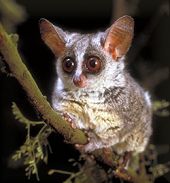
Bush Baby
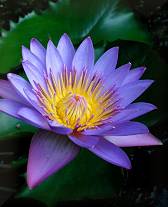
Day Water
Lily
|
|

|
 Our Plants
Our Plants
How
many Plant
Species?
"There is no reliable information available on the number
of plant species found in this area, but if it is kept in mind that
more than 2,000 species have been found in the Kruger Park alone, it
can be assumed that the geographic area as a whole could accommodate
more than 3,000 species."
(Preface by Piet van Wyk in: Transvaal Lowveld and Escarpment
including the Kruger National Park. South African Wild Flower
Guide 4 by Jo Onderstall, 1984)
|
|
|
Click
Don't Pick
All our indigenous plants
are protected by Law. You may not pick or collect any of them without
a permit.
|
|
|

Emperor Swallowtail butterfly
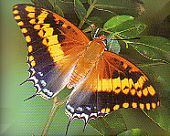
Foxy Emperor butterfly

Citrus Swallowtail caterpillar
|
 Our Butterflies
Our Butterflies
BUTTERFLIES
and MOTHS
The Hazyview region is
rich in both abundant and rare butterflies and moths. The warm, balmy
sub-tropical climate of Hazyview sustains prolific butterfly and moth populations throughout the year.
|
According to the distribution maps of Steve Woodhall's
"Field Guide to Butterflies of South Africa"
(ISBN 1 86872 724 6) one can expect to find up to 300 butterfly
species and sub-species in the greater Hazyview area. (That is about
half of all the butterfly species in South Africa.)

 Butterfl
Butterfl ies
Everywhere! 
You will find them in the gardens; along the roads; in the forests;
in the grassveld and along the streams. They refuse to be
caged and delight young and old alike with their colourful flutters
- and all without charging an entrance fee.
|
Collection
Please do not
collect butterflies without first checking with the Provincial
Nature Conservation offices, as some species are protected by law.
But you may 'capture' as many as you like with a good digital
camera.
|
 Checklist of our
Butterflies
Checklist of our
Butterflies 
|
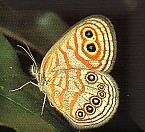
Zulu Shadefly butterfly
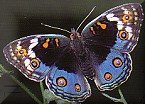
Eyed Pansy butterfly
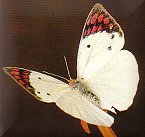
Queen Purple Tip butterfly

Window Winged moth
|
|
|

Pinkthroated Twinspot

Narina Trogon

Longcrested Eagle

Gorgeous Bush Shrike
|
 Our Birds
Our Birds
BIRDS
You can expect to find as many as 450 bird species in the Hazyview
area. That is
more than half of all the bird species in the whole of South Africa!
|
Rare Bird Sightings
(#Roberts Number):
Pennantwinged Nightjar (#410)
Eurasian Blackcap (#620.1)
Sooty Tern (#332)
Grey Wagtail (#715)
Bittern (#80)
Palmnut Vulture (#147)
Endangered,
Vulnerable and Threatened Birds:
(Links to Biodiversity Explorer's web site)
|
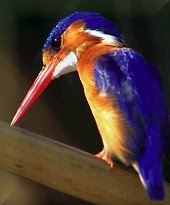
Malachite Kingfisher

Lilac-breasted Roller

Scarlet-chested Sunbird

Helmeted Guinea fowl

Trumpeter Hornbill
|
|
|
|
|

Bush Baby

Aardvark

African Wild Cat
|
 Our Mammals
Our Mammals
MAMMALS
With the Kruger National Park but a few kilometres away, one can
record and observe 150 species of mammals in the region. That's
more than half of all the mammals in South Africa!
|
The
KNP is renowned, not only for the Big-5, but also for its biodiversity
of other mammals. Be on the lookout for the Little-7:
like Bats, Elephant-shrews, Bush babies, Tree Squirrels, Aardvark,
Pangolins and the African Wild Cat.

Every
day at dusk, 42 species of Bats
take to the skies and gorge themselves on the bounty of insects
and fruit the Lowveld has to offer.
Mammals
and Landscapes
A delicate balance exist between the distribution of mammals & vegetation.
See our KNP Landscapes Page
|
|

Pangolin
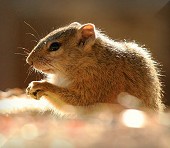
Tree Squirrel

Rock Elephant-shrew
|
|
|
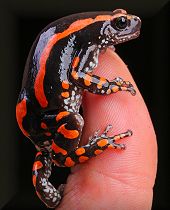
Banded Rubber Frog
|
 Our Amphibians
Our Amphibians
There are 35 frog and toad species in the area, each with it's
own characteristic call. After the first spring rains, and
throughout the summer, the Lowveld evenings come alive with the sounds
of croaks, whistles, chirps and guttural mating calls of these
fascinating creatures.
Our frogs and toads play a crucial role
in the delicate ecological balance of the region. These amphibians are also important
early indicators
of the state of health of our rivers and related aquatic systems.
 Checklist of our Amphibians
Checklist of our Amphibians 
|

Painted Reed Frog |
|
|

Leopard Tortoise

Horned Adder
|
 Our Reptiles
Our Reptiles
Of the 118 reptile species only one, the Natal Hinged Tortoise (Kinixys
natalensis), is classed by the Red Data List as "Near
Threatened".
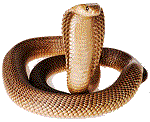
Of the 54
South African snakes, only 8 can be
considered highly venomous.
Fascinated by Reptiles?
Visit the Reptile Park
at
Perry's Bridge
|
|
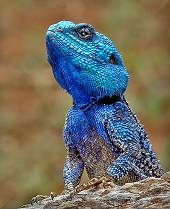
Tree Agama

Giant Plated Lizard
|
|
|

River Bream
|
 Our Fishes
Our Fishes
Fishes, although rarely seen, play a critical role in the
ecology of aquatic habitats and are a vital link in the food chain
for animals such s the Nile Crocodile and African Fish Eagle.
Two of the 53 ingenious fish species, the Barred Minnow (Opsaridium
perigueyi) and the Orange-fringed Largemouth (Astatotilapia
brevis) are listed in the Red Data List as
"Vulnerable".
|

Giant Mottled Eel
|
|
|
home
| about | contact |
biodiversity | accommodation |
health spas | cuisine | to do |
adventure | golfing |
birding |
shopping | sitemap
www.hazyviewinfo.co.za
copyright Trips ZA, 2020 |

